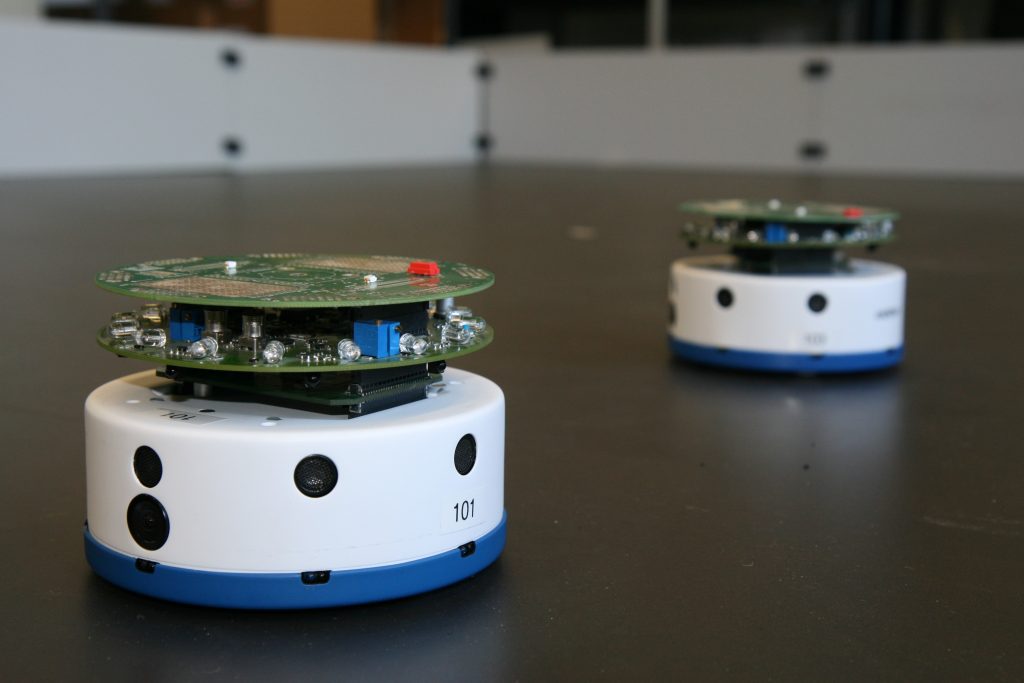
Multi-level modeling aims at bridging the gap between the physical reality of individual robots to the formal description of the collective behavior of multiple robots. Such modeling techniques not only allow us to simulate large groups of interacting robots, but they also help us to better understand the nature and functioning of collective behaviors. Numerous other groups worldwide have contributed to this modeling topic, but up to date all contributions have either failed to entirely bridge the real world with the highest abstraction level or have focused on restrictive experimental conditions in laboratory settings, therefore allowing for the formal definition of exclusively non-spatial models.
This project aims at relaxing this restriction of non-spatial models as well as to automatically generate the models in both their structure and parameters at different abstraction levels. Moreover, efforts are undertaken to leverage the multi-level modeling techniques in the inverse direction (from more abstract to more detailed models) to automatically generate individual robot controllers given a targeted collective behavior.
Team and Collaborators
In collaboration with:
- Masahiko Kurishige (Mitsubishi Electric)
- Masaki Haruna (Mitsubishi Electric)
- Tomoki Emmei (Mitsubishi Electric)
Research Period and Sponsors
This project started in October 2018.
Mitsubishi Electric is sponsoring this project for the duration of 1 year (renewable).
Related Student Projects and Internships
DISAL-SP185: Peter Harmouch, Using Artificial Neural Networks for the Automatic Design of Behavioral Arbitrators for Khepera IV Robots
DISAL-SU38: Justin Manson, Automatic Design of Behaviors for Khepera IV Robots
DISAL-SU36: Oussama Gabouj, Using neural networks to model a multi–robot lane driving scenario
DISAL-MP50: Lucas Bost, Automatic Design of Flexible Behavioral Arbitrators for Khepera IV Robots
DISAL-SP177: Justin Manson, Automatic Design of Behaviors for Khepera IV Robots
DISAL-SP176: David Fontes Junqueira, Discrete Optimization for Automatic Design of Behaviors for Khepera IV Robots
DISAL-IP39: Wakana Endo, Leveraging Multi-Level Modelling to Automatically Design Behavioral Arbitrators for Multi-Robot Search and Rescue
DISAL-SP174: Amélie Martin, Automatic Design of Behaviors for Khepera IV Robots Emulating Automotive Vehicles
CYBERBOTICS-DISAL-MP47: Benjamin Hug, Improving ROS support in Webots
DISAL-SP171: Léonard Pasi, Improving Mixed-Discrete Particle Swarm Optimization for Categorical Problems
DISAL-SP164: Hugo Miranda Queiros, Robot Operating System (ROS2) for Khepera IV Robots
DISAL-SP161: Maxime Zufferey, Automatic Design of Parallel Behavioral Arbitrators for Khepera IV Robots
DISAL-SP155: Jiaxuan Zhang, Simulation-Based Policy Improvement for Automatic Design of Behavioral Arbitrators for Khepera IV Robots
DISAL-SU32: Emna Tourki, Design, Execution and Analysis of Experimental Campaign for Hybrid Flocking-Formation Control Algorithms
DISAL-SP153: Arnaud Guibbert, Automatic Design of Behavioral Arbitrators for Khepera IV Robots: Comparing Optimization Algorithms to Generate a Finite State Machine
DISAL-SP147: Jonas Perolini, Using a Graph-Based Controller to Generate Flocking Behavior
DISAL-SP145: Raphael Uebersax, Calibration of High Fidelity Simulator Leveraging Machine-Learning Techniques
DISAL-SP143: Nathan Holzapfel, Enhanced On-line Collision Avoidance for Khepera IV Robots.
DISAL-SP141: Ivan Sievering, Automatic Design of Controllers for Khepera IV Robots: A Comparison Between Finite State Machine and Neural Network based Architectures for Flocking.
CYBERBOTICS-DISAL-MP44: Darko Lukic, ROS2 Programming Interface for the E-Puck2 Robot
DISAL-SP137: Hugo Birch, A Comparison Between Behavioral Arbitrator-Based and Neural Network Architectures
DISAL-SP136: Eric Bergkvist, Mixed-Discrete Particle Swarm Optimization, High-Dimensional Performance Evaluation and Comparison
Cyberbotics-DISAL-MP42: Michael Perret, Robot Modeling and Programming
DISAL-SP134: Zeki Erden, Towards Automatic Design of Controllers: Implementation of a Neural Network Controller Behavior using Khepera IV Robots
DISAL-SP133: Lucas Wälti, Automatic Design of Behavioral Arbitrators for Khepera IV Robots: A Comparison between Probabilistic Finite State Machines and Artificial Neural Networks
DISAL-SP132: Diana Petrescu, Towards Automatic Design of Controllers: Implementation of Machine-Learnable, Cooperative Behaviors for Khepera IV Robots
DISAL-SP128: Daniel Dias, Automatic Design of a Behavioral Arbitrator for Khepera IV Robots using Particle Swarm Optimization
DISAL-SP127: Jeremy Wanner, Towards Automatic Design of Controllers: Identification and Implementation of Basic Behaviors for Khepera IV Robots
Videos
Supplementary material for Hybrid Flock – Formation Control Algorithms
Publications
Please note that the publication lists from Infoscience integrated into the EPFL website, lab or people pages are frozen following the launch of the new version of platform. The owners of these pages are invited to recreate their publication list from Infoscience. For any assistance, please consult the Infoscience help or contact support.